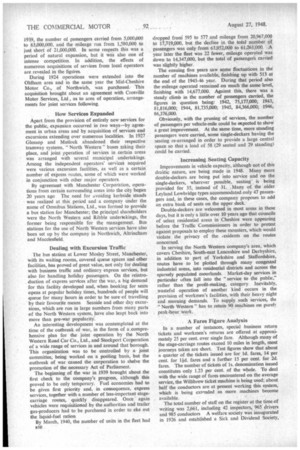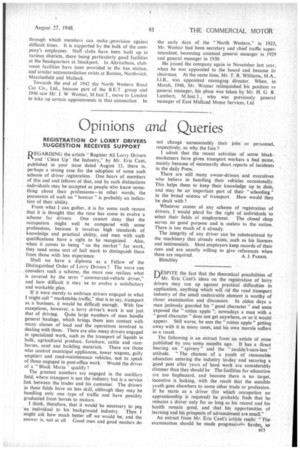P orth Westeril Celebrate
Page 42

Page 44

Page 47

If you've noticed an error in this article please click here to report it so we can fix it.
The Silver Jubilee Year of a Public Service Organization which Operates a Fleet of 542 Vehicles. How Transport Difficulties were Met and Overcome During the War Years.
SERV10E No. 1 in the time-tables of the North Western Road Car Co., Ltd., links Macclesfield with Buxton by a route which passes the "Cat and Fiddle," at 1,690 ft. England's second highest inn. These moors, often shrouded in cloud, are tough places for running even the most modern 'vehicles, but it was in this district that the foundatiolis of the " North Western" operations were laid.
Back in 1913, Mr. Sidney Garcke decided to set up a unit of the British Automobile Traction Co., Ltd., at Macclesfield, for here was a substantial industrial area, which, although served by railway lines running roughly north to south, had no facilities between points lying east and west. In those days road transport pioneers were scarcely more popular than railway prospectors of 80 years earlier.; but events began to move. Then in 114 came war, bringing with it the requisitioning of vehicles and, finally, such fuel restrictions that operations were almost closed down.
With the resumption of peace, the local fleet consisted of seven Belsize and two Daimler single-deck buses. Later in 1919 the Belsize machines were disposed of and the fleet extended by the acquisition of nine A.E.C. buses, together with three A.E.C. chars-6.-bancs. The passenger vehicle of those days was, of course, well built up on the robust, solid-tyred chassis, which could with equal success be incorporated in a brick lorry, and speeds were confined by law to 12 m.p.h.
In fact, the schedules themselves came close to that average, so that no doubt drivers often had to race up to the dizzy speed of 15-16 m.p.h. in order to keep abreast of the time-table. In districts where stops were not too frequent, buses would often be seen with a group of smartly pedalling cyclists tucked in behind and taking shelter, so as to reduce wind resistance. Some of
them contrived to hang on to the various projections at the back of buses, and during the period when speeds stood at such a convenient level some of them even. invented their own wire tow-bars .with loops or hooks which could easily be attached to the obliging bus.
In the course of the ensuing 12 months, local services were started at Buxton, there being a further development in 1921 when the area was extended to Stockport. By .that time the fleet had been increased to 30 machines and the annual mileage had topped the half-million mark. Business was obviously developing upon the right lines, with the result that B.A.T. decided to appoint a Peak District sub-committee to watch over the local interests. The appointment of the committee foreshadowed the disappearance of buses bearing the " British " name from the locality, for it was decided that the British Automobile Traction Co., Ltd., and Thomas Tilling, Ltd., should jointly form the North Western Road Cat Co., Ltd. Early in 1923 the existing fleet of 51 machines was taken over.
In this year of 1948 the North Western organization attained its silver jubilee, and it is interesting to observe that the fleet had in that time reached a figure of 542 units; passengers carried had advanced from 2,628,000 to 103,830,000, whilst the mileage run had increased from 838,000 to 22,820,000. Up to the time of the foundation of the new company, the headquarters and main garage had been at Macclesfield, but shortly afterwards they were transferred to Stockport. A fuller description of many facilities now to be found there will appear in next week's issue of The Commercial Motor."
Statistics show • steadily increasing scope throughout the 15 years until the beginning of the recent war. The fleet climbed from 73 at March, 1924, to 595 at March. 1939, the number at passengers carried from 5,000,000 to 63,000,000, and the mileage run from 1,580,000 to just short of 21,000,000 In some respects this was a period of natural expansion, but it was also one of intense competition. In addition, the effects of numerous acquisitions of services from local operators are revealed in the figures.
During 1924 operations were extended into the Oldham area and in the same year the Mid-Cheshire Motor Co:, of Northwich, was purchased.. This acquisition brought about an agreement with Crosville Motor Services, Ltd , as to area of operation, arrangements for joint services following.
, How Services Expanded Apart from the provision of entirely new services for the public, expansion occurred in two ways—by agreement in urban areas and by acquisition of services and excursions extending over numerous localities. In 1927 Glossop and Matlock abandoned their respective tramway systems, "North Western" buses taking their place, and joint pperation of services in certain areas was arranged with several municipal undertakings. Among the independent operators' services acquired were various excursion facilities, as well as a certain' number of express routes, some of which were worked in conjunction with other major operators.
By agreement with Manchester Corporation, operations from certain surrounding areas into the city began 20 years ago The need for avoiding kerbside stands was realized at this period and a company under the name of Omnibus Stations, Ltd., was formed to provide a bus station for Manchester; the principal shareholders were the North Western and Ribble undertakings, the former being responsible for the management. Bus stations for the use of North Western services have also been set up by the company in Northwich, Altrincham and Macclesfield.
Dealing with Excursion Traffic The bus station at Lower Mosley Street, Manchester, with its waiting rooms, covered queue spaces and other facilities, has proved of great value, not only for dealing with business traffic and ordinary express services, but also for handling holiday passengers. On the reintroduction of express services after the war, a big demand for this facility developed and, when booking for seats opens at popular holiday times, hundreds of people will queue for many hours in order to be sure of travelling • by their favourite means Seaside and other day excursions, which are run in large numbers from many parts of the North Western system, have also leapt back into more than pre-war popularity.
An interesting development was contemplated at the time of the outbreak of war, in the form of a _comprehensive plan for the joint operation by the North Western Road Car Co_, Ltd., and Stockport Corporation of a wide range of services in and around that borough. This organization was to be controlled by a joint committee, being worked on a pooling basis, but the outbreak of war caused the corporation to shelve the promotion of the necessary Act of Parliament.
The beginning of the war in 1939 brought about the first check to the company's progress, although this proved to be only temporary. Fuel economies had to be given first priority and, in consequence, express services, together with a number of less-important stagecarriage routes, quickly disappeared. Once again vehicles were requisitioned by the authorities and trailer gas-producers had to be purchased in order to eke out the liquid-fuel ration By March, 1940, the number of units in the fleet had rilf) dropped frorri 595 to 577 and mileage from 20,967,000 to 17,719,000, but the decline in the total number of passengers was only from 63,052,000 to 61,261,000. :A year later the fleet was 22 fewer, mileage operated was down to 14,347,000, but the total of passengers carried was slightly higher.
The ensuing five years saw some fluctuations in the number of machines available, finishing up with 513 at the end ot the 1945-46 year. During that period also the mileage operated remained on much the same level, finishing with 14,677,000. Against this, there was a steady climb in the number of passengers carried, the figures in question being: 1942, 75,177,000; 1943, 81,816,000; 1944, 81,735,000; 1945, 84,366,000; 1946, 86,376,000.
Obviously, with the pruning of services, the number of passengers per vehicle-mile could be expected to show a great improvement. At the same time, more standing passengers were carried, some single-dickers having the seating re-arranged in order to provide a large central space so that a load of 58 (29 seated and 29 standingl could be carried.
Increasing Seating Capacity Improvements in vehicle capacity, although not of this drastic nature, are being made in 1948. Many more double-deckers are being put into service and on the single-deckers, wherever possible, seating' is being provided for 35, instead of 31. Many of the older Leyland Lowbridge types accommodated only 47 passengers and, in these cases, the company proposes to add an extra bank of seats on the upper deck.
Double-deckers are welcomed in most areas in these days, but it is only a little over 10 years ago that councils of select residential areas in Cheshire were appearing before the Traffic Commissioners in order to protest against proposals to employ these monsters, which would violate the privacy of the iesidents on the routes concerned.
In serving the North Western company's area, which covers Cheshire, South-east Lancashire and Derbyshire, in addition to part of Yorkshire and Staffordshire, routes have to be plotted through many congested industrial areas, into residential districts and across the sparsely populated moorlands. Market-day services in particular often fall into the "service to the public," rather than the profit-making, category. Inevitably, wasteful operation of another kind occurs in the provision of workmen's facilities, with their heavy night and morning demands. To supply such services, thc "North Western" has to retain 90 machines on purel peak-hour work.
A Fares Figure Analysis In a number of instances, special business return tickets and workmen's returns are offered at approximately 25 per cent. over single fare. Although many of the stage-carriage routes exceed 10 miles in length, most journeys taken are short. Test figures show that about a quarter of the tickets issued are for Id. fares, 14 per cent. for lid. fares and a further 15 per cent. for 2d. fares. The number of tickets of ls. denomination issued constitutes only 1.23 per cent. of the whole. To deal with the wide range of fares encountered on the average service, the Willibrew ticket machine is being used; about half the conductors are at present working this system, which is being extPnded as more machines become available.
The total number of staff on the register at the time of writing was 2,661, including 42 inspectors, 965 drivers and 985 conductors A welfare society was inaugurated in 1926 and established a Sick and Dividend Society, through which members can make .iprovision against difficult times. It is supported by the bulk of the company's employees. Staff clubs have been built up in various districts, there being particularly good facilities at the headquarters at Stockport. In Altrincham, clubroom facilities have been provided in the bus station. and similar accommodation exists at Buxton, Northwich, Macclesfield and Matlock Towards the end of 1942 the North Western Road Car Co., Ltd., became part of the B.E.T. group and 1946 saw Mr. J. W Womar, M.Inst.T., move to London to take up certain appointments in that connection In
the early days of the "North Western," in 1923, Mr. Womar had been secretary and chief traffic superintendent, becoming assistant general manager in 1929 and general manager in 1930.
He joined the company again in November last year, when he was appointed to the board and became its chairman. At the same time, Mr. T. R. Williams, M.A., LLB., was appointed managing director. When, in March, 1946, Mr. Womar relinquished his position as general manager, his place was taken by Mr. H. G R Lambert, M.Inst.I ., who was previously general manager of East Midland Motor Services, Ltd




















































































